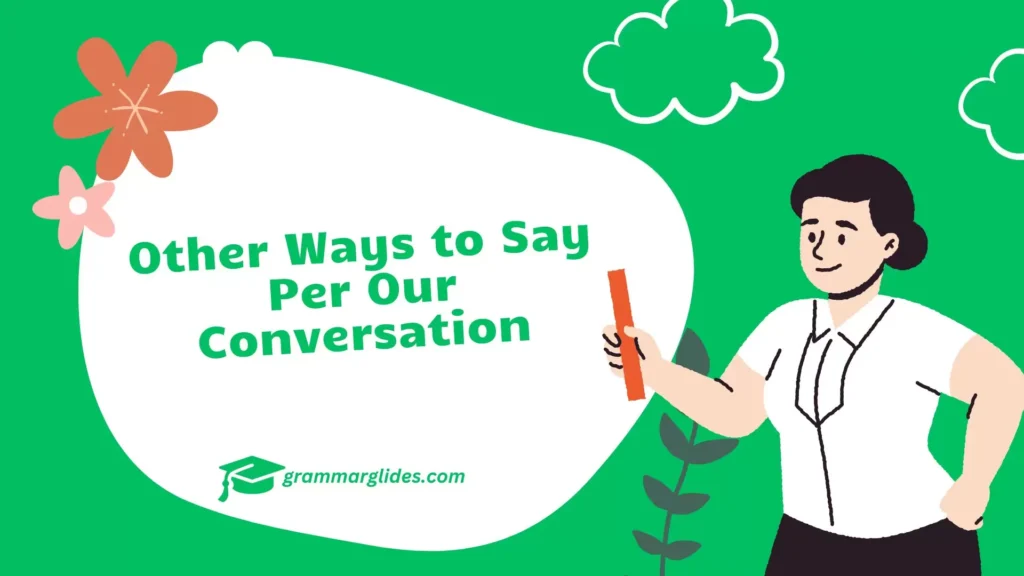When communicating in a professional or formal setting, there are several alternative ways to say “per our conversation” that can help you vary your language while maintaining clarity. These phrases often convey the same meaning but with a slightly different tone or nuance, making them more suitable for various contexts.
In business, emails, or casual professional exchanges, it’s essential to adjust the phrasing based on the relationship, formality level, and the type of communication. Whether you’re confirming action items, acknowledging a request, or clarifying information, using alternative expressions can help you sound polished and approachable. This can also reflect your flexibility in language use, which might be appreciated by colleagues or clients.
Some of the commonly used alternatives include phrases like “as discussed,” “following our discussion,” or “as we talked about.” Each of these variations can subtly change the tone of your message, while still pointing back to a previous interaction or agreement. Choosing the right one depends on the context, but these alternatives all maintain the same essence of acknowledging a prior communication.
Using diverse expressions can keep your communication fresh and effective, especially when you’re following up on previous discussions or confirming details. This blog post explores 30 alternative phrases to use in place of “Per our conversation,” complete with scenarios, examples, and explanations.
What does “as per our conversation” mean?
“Per our conversation” is a phrase commonly used in professional settings to refer to something that was previously discussed or agreed upon. It is a way of reminding or referencing a past conversation to confirm details, actions, or expectations.
The phrase indicates that the following message or action aligns with what was previously addressed in a discussion. It serves as a polite and formal way of bringing the conversation back into focus, ensuring both parties are on the same page. Using this expression is particularly useful in business communication, emails, or when following up on agreed-upon points.
When to use “per our conversation” in email?
Use “Per our conversation” in an email when referencing a previous discussion to confirm details, summarize key points, or outline agreed actions. It helps ensure clarity and alignment between both parties.
You can use it at the beginning of an email to remind the recipient of what was discussed or within the body to introduce specific points. For example, “Per our conversation, I will send the updated report by Friday.”
1. As Discussed

Scenario: You’re following up on a meeting about project deadlines.
Example 1: “As discussed, the project deadline has been moved to next Friday.”
Example 2: “As discussed in our last meeting, please find the updated timeline attached.”
Explanation: “As discussed” directly refers to a prior conversation, making it clear that you’re referring back to what was previously talked about.
2. Following Our Discussion
Scenario: You’re sending a document that was talked about in a recent call.
Example 1: “Following our discussion, I’m attaching the report we talked about.”
Example 2: “Following our discussion about the budget, please review the updated figures.”
Explanation: “Following our discussion” indicates that the information being shared is a result of the prior conversation.
3. In Reference to Our Talk

Scenario: You’re confirming a decision made during a recent conversation.
Example 1: “In reference to our talk, the new policy will be implemented next month.”
Example 2: “In reference to our talk about the marketing strategy, here’s the revised plan.”
Explanation: “In reference to our talk” is a formal way to cite a previous conversation and is useful for professional settings.
4. As We Talked About
Scenario: You’re sending an update on a project discussed in a meeting.
Example 1: “As we talked about, the project’s next phase will begin next week.”
Example 2: “As we talked about earlier, I’m sending you the updated contract for review.”
Explanation: “As we talked about” connects directly to the subject of the previous discussion, making it clear and straightforward.
Other Ways to Say Thank You for Your Understanding
5. Referring to Our Recent Conversation
Scenario: You’re following up on a client’s request.
Exam2ple 1: “Referring to our recent conversation, here is the detailed proposal.”
Example 2: “Referring to our recent conversation, I’ve included the requested documents.”
Explanation: “Referring to our recent conversation” formalizes the reference and indicates that the follow-up is based on the recent discussion.
6. Per Our Previous Discussion

Scenario: You’re confirming details agreed upon in a past meeting.
Example 1: “Per our previous discussion, the meeting is scheduled for Tuesday.”
Example 2: “Per our previous discussion, the design changes have been approved.”
Explanation: “Per our previous discussion” provides a formal and clear reference to the earlier conversation.
7. As We Discussed Earlier
Scenario: You’re updating someone on a decision made in a prior meeting.
Example 1: “As we discussed earlier, I’ve updated the project timeline.”
Example 2: “As we discussed earlier, the new procedures are now in place.”
Explanation: “As we discussed earlier” emphasizes the continuity from a prior conversation to the current update.
8. In Line with Our Conversation

Scenario: You’re providing additional information following a call.
Example 1: “In line with our conversation, I’m sending over the detailed specs.”
Example 2: “In line with our conversation about the event, please find the updated agenda.”
Explanation: “In line with our conversation” suggests that the action or information is aligned with what was discussed previously.
9. As Mentioned Previously
Scenario: You’re confirming a point discussed in a previous email.
Example 1: “As mentioned previously, the contract has been revised as per our agreement.”
Example 2: “As mentioned previously, the team will start the new project phase on Monday.”
Explanation: “As mentioned previously” refers back to a point made earlier and reinforces the connection between the prior and current communication.
10. According to Our Discussion

Scenario: You’re following up with action items from a meeting.
Example 1: “According to our discussion, I’ve attached the project plan for your review.”
Example 2: “According to our discussion about the budget, the adjustments have been made.”
Explanation: “According to our discussion” formally references the previous conversation and indicates adherence to what was agreed upon.
11. As We Agreed Upon

Scenario: You’re confirming an agreement made during a conversation.
Example 1: “As we agreed upon, the new terms have been added to the contract.”
Example 2: “As we agreed upon during our call, the launch date is set for next month.”
Explanation: “As we agreed upon” emphasizes that the follow-up is based on mutual agreement from the earlier conversation.
12. In Accordance with Our Conversation

Scenario: You’re sending a follow-up email with requested information.
Example 1: “In accordance with our conversation, here is the requested information.”
Example 2: “In accordance with our conversation, I’ve included the revised schedule.”
Explanation: “In accordance with our conversation” indicates compliance with what was discussed previously.
13. As Outlined in Our Discussion
Scenario: You’re providing detailed information discussed in a meeting.
Example 1: “As outlined in our discussion, the project deliverables are now defined.”
Example 2: “As outlined in our discussion, here is the updated policy document.”
Explanation: “As outlined in our discussion” refers to specific points that were detailed during the conversation.
14. Based on Our Previous Conversation

Scenario: You’re sending follow-up details on a topic discussed earlier.
Example 1: “Based on our previous conversation, I’ve attached the necessary documents.”
Example 2: “Based on our previous conversation, here’s the updated project timeline.”
Explanation: “Based on our previous conversation” suggests that the action or information is directly related to what was discussed before.
15. Following Up on Our Talk
Scenario: You’re checking in on action items from a previous discussion.
Example 1: “Following up on our talk, I’ve sent the revised proposal for your review.”
Example 2: “Following up on our talk, please see the updated schedule attached.”
Explanation: “Following up on our talk” indicates that you’re continuing the discussion with additional information or updates.
16. In Reference to Our Recent Discussion

Scenario: You’re providing further details on a topic discussed recently.
Example 1: “In reference to our recent discussion, I’m sending over the final report.”
Example 2: “In reference to our recent discussion, here’s the updated marketing plan.”
Explanation: “In reference to our recent discussion” formally ties the follow-up to the earlier conversation.
17. As Previously Mentioned
Scenario: You’re reiterating a point made in an earlier communication.
Example 1: “As previously mentioned, the deadline for the project has been extended.”
Example 2: “As previously mentioned, the changes to the policy will take effect next month.”
Explanation: “As previously mentioned” reinforces points made earlier and ensures continuity in communication.
18. As Discussed in Our Meeting

Scenario: You’re following up on action items from a meeting.
Example 1: “As discussed in our meeting, I’ve attached the revised project plan.”
Example 2: “As discussed in our meeting, the budget has been updated as per the new figures.”
Explanation: “As discussed in our meeting” directly refers to the conversation held during the meeting.
19. Per Our Recent Talk
Scenario: You’re sending a follow-up message based on a recent discussion.
Example 1: “Per our recent talk, please find the revised schedule attached.”
Example 2: “Per our recent talk, I’ve included the updated specifications for review.”
Explanation: “Per our recent talk” is a concise way to reference a recent conversation and provide related information.
20. Following Up on Our Recent Meeting

Scenario: You’re providing additional details after a recent meeting.
Example 1: “Following up on our recent meeting, here is the updated project proposal.”
Example 2: “Following up on our recent meeting, please review the attached document.”
Explanation: “Following up on our recent meeting” indicates that the communication is a continuation of what was discussed in the meeting.
21. As We Covered
Scenario: You’re sending a summary or update on what was discussed.
Example 1: “As we covered, the new policy will be implemented next month.”
Example 2: “As we covered in our discussion, here’s the revised timeline for the project.”
Explanation: “As we covered” refers to the topics or points discussed and provides a follow-up on those areas.
22. In Alignment with Our Discussion
Scenario: You’re sending a follow-up email related to what was discussed.
Example 1: “In alignment with our discussion, I’ve attached the updated proposal.”
Example 2: “In alignment with our discussion, here’s the revised plan for your review.”
Explanation: “In alignment with our discussion” suggests that the follow-up is consistent with what was discussed earlier.
23. As Previously Discussed

Scenario: You’re confirming details from a previous conversation.
Example 1: “As previously discussed, the contract has been finalized.”
Example 2: “As previously discussed, the meeting is scheduled for next Wednesday.”
Explanation: “As previously discussed” is a formal way to reference and confirm points from earlier conversations.
24. In Accordance with Our Earlier Conversation
Scenario: You’re providing details or documentation as per a prior discussion.
Example 1: “In accordance with our earlier conversation, I’m sending the revised document.”
Example 2: “In accordance with our earlier conversation, the changes have been made to the schedule.”
Explanation: “In accordance with our earlier conversation” emphasizes adherence to what was agreed upon or discussed before.
25. Per Our Earlier Meeting
Scenario: You’re following up with additional information discussed in an earlier meeting.
Example 1: “Per our earlier meeting, I’ve attached the project outline for review.”
Example 2: “Per our earlier meeting, here is the updated proposal document.”
Explanation: “Per our earlier meeting” references the discussion held in the past meeting and relates the current communication to it.
26. As We Covered Earlier
Scenario: You’re sending an update or confirmation based on an earlier discussion.
Example 1: “As we covered earlier, the new terms are effective immediately.”
Example 2: “As we covered earlier, the revised deadlines are now in place.”
Explanation: “As we covered earlier” highlights that the current communication is based on earlier discussion points.
27. In Response to Our Previous Talk
Scenario: You’re providing a response or follow-up to a previous conversation.
Example 1: “In response to our previous talk, here’s the finalized report.”
Example 2: “In response to our previous talk, please review the attached revisions.”
Explanation: “In response to our previous talk” indicates that the current communication is addressing or following up on a past conversation.
28. Following Up on Our Recent Discussion
Scenario: You’re providing additional information after a recent discussion.
Example 1: “Following up on our recent discussion, I’ve included the updated budget.”
Example 2: “Following up on our recent discussion, here’s the revised schedule.”
Explanation: “Following up on our recent discussion” provides continuity and indicates that the message is related to a recent conversation.
29. As We Previously Covered
Scenario: You’re summarizing or confirming details discussed earlier.
Example 1: “As we previously covered, the new policy will be implemented next month.”
Example 2: “As we previously covered in our call, here’s the updated timeline.”
Explanation: “As we previously covered” refers to earlier discussions and provides a summary or confirmation based on that.
30. Per Our Previous Talk

Scenario: You’re sending an update based on a previous conversation.
Example 1: “Per our previous talk, please find the updated documents attached.”
Example 2: “Per our previous talk, the new project timeline is now set.”
Explanation: “Per our previous talk” succinctly connects the current communication to a prior conversation.
As per our conversation over the phone email sample
Subject: Follow-Up on Our Phone Conversation
Dear [Recipient’s Name],
I hope you’re doing well.
As per our conversation over the phone, I wanted to follow up on [mention the topic discussed]. We talked about [briefly summarize key points], and I wanted to confirm [specific details, action items, or next steps].
Please let me know if you need any further clarification or if there are any updates on your end. Looking forward to your response.
Best regards,
[Your Name]
[Your Position]
[Your Contact Information]
Key Insight
1. Why should I use alternatives to “Per Our Conversation”?
Using different phrases can make your communication sound more natural, engaging, and professional. It helps avoid repetition and ensures your message is clear and appropriate for different contexts.
2. What are some formal alternatives to “Per Our Conversation”?
Formal alternatives include “As we discussed,” “Following up on our conversation,” and “To recap our discussion.” These phrases maintain a professional tone while reinforcing prior communication.
3. Can I use casual alternatives in professional emails?
Yes, but it depends on your audience. If writing to a colleague, phrases like “Just a quick follow-up” or “As we talked about” can be acceptable. However, for formal settings, it’s best to use more professional language.
4. What is the best alternative for legal or contractual communication?
For legal or contractual discussions, precise wording is important. Phrases like “As previously agreed,” “As outlined in our discussion,” or “As stated in our agreement” are suitable to ensure clarity.
5. How can I make my email sound more polite when referring to a past conversation?
Adding politeness and warmth can improve your message. Try using phrases like “Thank you for our discussion earlier” or “I appreciate our conversation and wanted to follow up on…” to create a professional yet friendly tone.
Conclusion
Using alternative phrases to “Per our conversation” can enhance your communication by adding variety and specificity. Each of these 30 alternatives helps in referencing past discussions in a way that suits different contexts and forms of communication.
By choosing the right phrase, you can make your follow-ups clearer and more aligned with the nature of your previous conversations.

Hi! I’m Lauren Reynolds, the author of Grammar Glides. I create easy-to-follow content that helps you master English with confidence. Let’s make learning English simple and enjoyable together!

